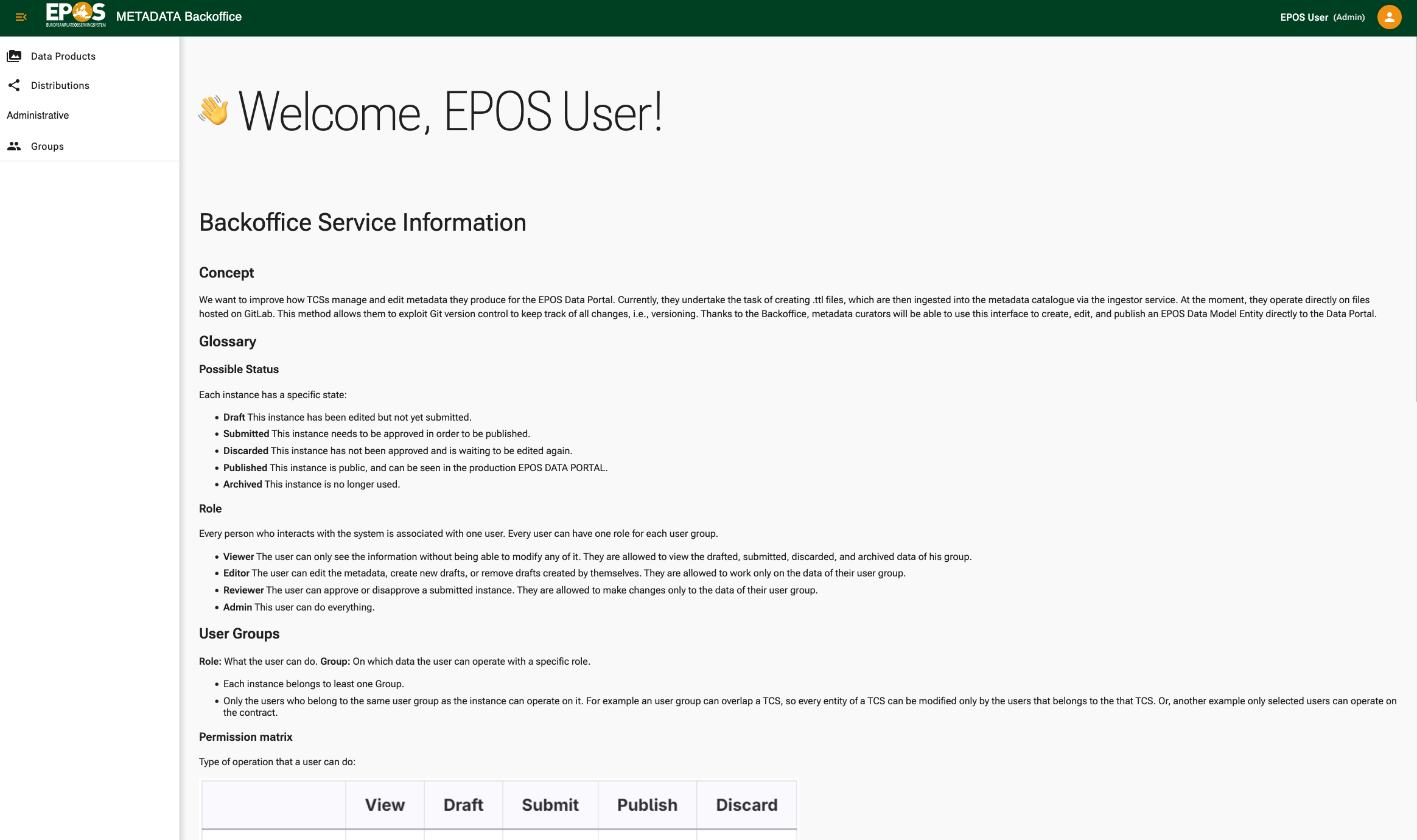Backoffice Service

The Backoffice Service is a web-based interface designed to provide intuitive and comprehensive management of the EPOS Platform's metadata. It works in conjunction with a dedicated backend service to streamline the process of curating and maintaining service descriptions within your data catalogue.
Why the Backoffice?
Previously, managing metadata involved manual editing of complex Turtle files, a process prone to errors and requiring significant technical expertise. The Backoffice was developed to overcome these challenges by:
- Simplifying Metadata Management: Eliminating the need for direct interaction with Turtle files or the EPOS-DCAT-AP specification.
- Enabling Direct Manipulation: Allowing users to create, edit, and publish EPOS Data Model Entities (service descriptions) directly through a user-friendly graphical interface.
- Streamlining Updates: Facilitating immediate reflection of approved changes in the main Platform GUI, without requiring full application redeployments.
- Ensuring Data Integrity: Reducing human error through an intuitive interface and built-in validation, while exploiting Git version control for tracking changes.
Key Features
The Backoffice provides a robust set of features for metadata administration:
- Graphical Metadata Editor: Create, edit, and delete service descriptions using an intuitive web interface.
- Metadata Versioning: Leverage Git-like version control to track all changes to metadata entities.
- Secure Access Control: Implement a robust model of groups, users, and roles to manage permissions for metadata operations.
- Metadata Workflow: Manage metadata through a defined lifecycle (Draft, Submitted, Discarded, Published, Archived) with review and approval processes.
- Metadata Preview: Review changes in a dedicated preview section before they are published to the main Platform GUI.
Metadata Workflow and Entity Lifecycle
The Backoffice introduces a structured workflow for managing metadata entities, ensuring quality control and traceability. Each metadata instance progresses through a defined lifecycle:
Possible Statuses
- Draft: The instance has been edited but not yet submitted for review. It can be freely edited or removed.
- Submitted: The instance has been submitted and is awaiting approval to be published.
- Discarded: The instance has not been approved by a reviewer and needs further editing. An editor can create a new draft from this state.
- Published: The instance is public and visible in the production EPOS Platform.
- Archived: The instance is no longer actively used but is retained for historical purposes, allowing for potential rollbacks.
Life Cycle of an Entity
- Drafting: An editor drafts a new entity or edits an existing one. (DRAFT state)
- Submission: When the editor is satisfied, they submit the entity for review. (SUBMITTED state)
- Review and Publication: A reviewer checks the submitted instance. If approved, the changes are published (PUBLISHED state), and the previously published version is moved to ARCHIVED state.
- Discarding: If the reviewer disapproves, the changes are discarded (DISCARDED state). An editor can then create a new draft from this discarded version.
Access Control and Roles
The Backoffice implements a granular access control system based on users, roles, and user groups to ensure secure and structured metadata management.
Roles
Every user interacting with the system is assigned a role, defining their permissions:
- Viewer: Can only view information without modification rights. Allowed to see drafted, submitted, discarded, and archived data within their assigned groups.
- Editor: Can edit metadata, create new drafts, and remove their own drafts. Operations are restricted to data within their assigned user groups.
- Reviewer: Can approve or disapprove submitted instances. Allowed to make changes only to data within their assigned user groups.
- Admin: Has full administrative privileges, capable of performing all actions across the system.
User Groups
Roles define what a user can do, while user groups define on which data a user can operate with a specific role.
- Each metadata instance belongs to at least one user group.
- Only users who belong to the same user group as an instance can operate on it. For example, a user group can correspond to a TCS (Thematic Core Service), allowing only users from that TCS to modify its entities.
Permission Matrix
| External User | View | Draft | Submit | Publish | Discard |
|---|---|---|---|---|---|
| Viewer | ✓ | ||||
| Editor | ✓ | ✓ | ✓ | ||
| Reviewer | ✓ | ✓ | ✓ | ||
| Admin | ✓ | ✓ | ✓ | ✓ | ✓ |
Accessing the Backoffice
Benefits
By centralizing and simplifying metadata management, the Backoffice significantly enhances the usability and maintainability of the EPOS Platform for both data providers and administrators. It promotes a more agile and collaborative approach to data curation, ensuring that your data catalogue remains accurate and up-to-date with minimal effort.